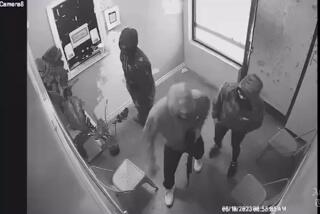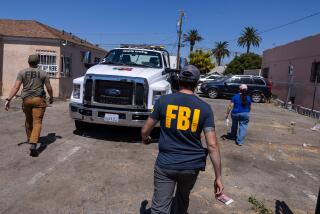Some Suspects Put Themselves in the Picture
The heist is all over.
No flashing police lights. No bystanders waiting for their chance to play hero. Just a clean getaway . . . and thousands of free-and-clear dollars.
All that remains is to count up the loot and celebrate with co-conspirators.
And put it all on videotape.
Emboldened criminals around the Valley are increasingly apt to create memorials to their misdeeds in the form of photographs or videos of them either committing a crime or enjoying its aftermath. Often, detectives say, that supplies the very proof needed to convict them.
Depictions of this show of defiance have been incorporated in movies such as “Bonnie & Clyde” and “Menace II Society.” In the latter film, a hard-core Los Angeles gang member takes delight in viewing and reviewing a copy of the security camera video of himself fatally shooting a Korean grocery store owner.
Perhaps the most famous Valley example in recent years provided a memorable centerpiece to the 1994 trial of Mary Ellen Samuels, who was convicted of orchestrating the murders of her estranged husband and the man she hired to kill him.
Prosecutors began their case with a can’t-lose piece of evidence: a blown-up photo of Samuels lying on a bed in a Cancun hotel, wearing only $20,000 in large bills and a smile. Eliciting gasps from spectators and disbelieving looks from jurors, they displayed the photo, proclaiming she was “clothed only in the blood money of her husband.”
Most examples are not as spectacular or bloody. But conversations with law enforcement veterans show this illogical tendency is hardly uncommon.
Last year, a group of teenage thieves in Santa Clarita made a habit of knocking over residential garages, making off with cellular phones and even garage-door openers. It was a lucrative enterprise for a time, authorities say--until they found a video camera in one garage.
Unable to suppress the urge to preen, the teens mugged for the camera. The owner of the camera did not find the footage until after they had been apprehended, but sheriff’s Det. Mitch Clark said it gave investigators a hearty chuckle.
“We had enough evidence on them anyway, but I have no idea why someone would do that,” he said. “It’s probably just ego. They were juveniles and they thought it was fun.”
Frequently, criminals caught up in the euphoria of the act are convinced they are above the law.
“They tend to think that they’re too good to be caught, and this is just an extension of that,” Clark said.
At the opposite end of the spectrum from the careless perpetrators are gang members who scrupulously record every “job” they perform.
Det. Steve Laird of the LAPD’s bank robbery unit said the structure of gang life leads to documentation.
“We apprehend people all the time who are actually carrying Polaroids of the money they stole and the gun they used for the holdup,” he said.
Hangouts of Asian gangs in particular, Laird said, often have entire albums of photographs documenting the gang’s activities. Some have even appointed a gang member to make a documentary video.
“They are displays of pride. They’re very proud of their history and it seems that they always want to memorialize it,” Laird said. “They take some beautiful pictures. They’re sometimes such high quality that you have to wonder why they don’t invest the same effort in something else. Because we usually catch up with them.”
More to Read
Sign up for Essential California
The most important California stories and recommendations in your inbox every morning.
You may occasionally receive promotional content from the Los Angeles Times.









